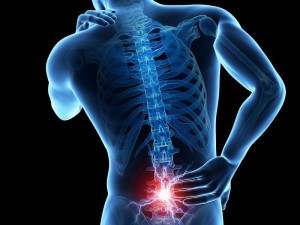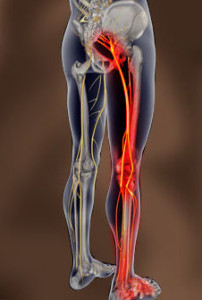What is Lumbar Radiculopathy?
Lumbar refers to the low back region. Nerve roots in the lumbar exit the back to enter the legs. Nerve roots branch out from the spinal cord and carry messages to and from the brain and the lower extremities and pelvis. If one of these roots is sick or injured in the area where it leaves the spine, it is called a lumbar radiculopathy. Symptoms usually arise in people between the ages of 30 and 50 and may follow an injury, or occur with no warning. Sciatica is pain radiating from the back down the back of the leg, and is a form of lumbar radiculopathy. Other common symptoms are numbness and tingling of the leg or foot, weakness, and muscle spasms. 80% to 90% of patients with sciatica recover without surgery.
What causes Lumbar Radiculopathy?
Many disease states can cause lumbar radiculopathy. Most often it is a structural problem like a herniated disc, bone spur, or mechanical stretching or traumatic event. Discs may be damaged from strenuous activity, a congenital defect, or by injury. When the disc is damaged, material in the disc leaks and squeezes the nerve root. This can cause the numbness, tingling, pain, and weakness.
How is it diagnosed?
After initial examination, the diagnosis of lumbar radiculopathy can be supported by electrodiagnosis, MRI, CT scans, and/or contrast myelography. Treatment of lumbar radiculopathy will vary depending on the actual cause of the lumbar radiculopathy. These treatments can include the use of back supports, medication, physical therapy, steroid injection in the spine, and even surgery.
Radicular pain is often secondary to compression or inflammation of a spinal nerve. When the pain radiates down the back of the leg to the calf or foot, it would be described as sciatica. This type of pain is often deep and steady. It can usually be reproduced with certain activities and positions, such as sitting or walking.

Radicular pain may be accompanied by numbness and tingling, muscle weakness and loss of specific reflexes. When actual nerve dysfunction is noted (prior noted symptoms), this is termed radiculopathy.

A radiculopathy is caused by compression, inflammation and/or injury to a spinal nerve root in the low back. It is often referred to as sciatica.
Symptoms
The pain usually follows the involved dermatome in the leg – the area of distribution of the leg covered by the specific nerve. When a nerve at the L4-5 or L5-S1 level is affected (lowest levels), tit is usually the sciatic nerve, which runs down the back of each leg to the foot.
Radicular pain may also be accompanied by numbness and tingling, muscle weakness and loss of specific reflexes. When actual nerve dysfunction is noted (prior noted symptoms), this is termed radiculopathy.
Radicular pain radiates into the lower extremity (leg, and occasionally the foot) directly along the course of a specific spinal nerve root. The most common symptom of radicular pain is sciatica. Pain that radiates along the sciatic nerve down the back of the thigh and calf into the foot. Sciatica is one of the most common forms of pain caused by compression of a spinal nerve in the low back. It often will be caused by compression of the lower spinal nerve roots (L5 and S1).
With this condition, the leg pain is typically much worse than the low back pain. The specific areas of the leg and/or foot that are affected depends on which nerve in the low back is affected. Compression of higher lumbar nerve roots such as L2, L3 and L4 can cause radicular pain into the front of the thigh and the shin.
Diagnosis of Lumbar Radiculopathy
A radiculopathy is caused by compression, inflammation and/or injury to a spinal nerve root in the low back. Causes of this type of pain, in the order of prevalence, include:
- Herniated disc with nerve compression – by far the most common cause of radiculopathy
- Foraminal stenosis (narrowing of the hole through which the spinal nerve exits due to bone spurs or arthritis) – more common in elderly adults
- Diabetes
- Nerve root injuries
- Scar tissue from previous spinal surgery that is affecting the nerve root
Sciatica, the term commonly used to describe radicular pain along the sciatic nerve. It describes where the pain is felt but is not an actual diagnosis. The clinical diagnosis is usually arrived at through a combination of the patient’s history (including a description of the pain) and a physical exam. Imaging studies (MRI, CT-myelogram) are used to confirm the diagnosis and will typically show the impingement on the nerve root.
 Skip to content
Skip to content
